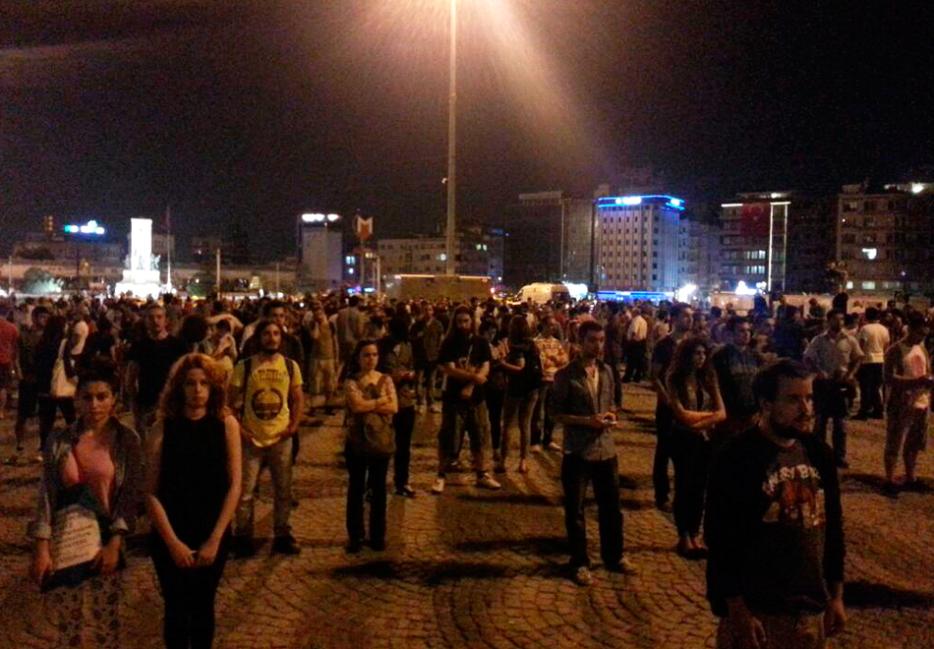Out, damned spot! It’s always Lady Macbeth that comes to mind when I think about metonymy—a specific kind of metaphor in which a part stands for the whole. Her hands, my high school English teacher told us, were her conscience, now impossible to clean. I don’t know if Ms. Paterson was quite right about that, but lately I’ve been thinking about metonyms because of the protests in Turkey.
As the populist revolt there continues, part of the resistance has been captured by the standing man meme. It began when a lone man, possibly performance artist Erdem Gündüz, was photographed from behind staring at the Turkish flag. As the description on Gawker suggests, he is made fun of, questioned by police, but eventually joined by others, after which the protest meme spreads around the country. From the outside—whether in Turkey or abroad—we are left these stark pictures of people simply standing.
Protests are inherently metonymic. There is never a time that all the inhabitants of a city or state come together to voice their displeasure; it is always the people in the square standing in as a symbol for everyone else. More broadly speaking, though, symbolism and politics are indivisible. Politics is always about representation, mostly because representation has at least two meanings: to depict or show, and to stand or speak for. Think of it this way: Lindsay Lohan might show up in a representation of Linda Lovelace’s life, but in court, it’s her lawyer who represents her.
It’s that doubled sense of representation that makes modern political protest so potent. Because the massively increased availability of media concentrates the effects of at least the showing part, that relationship between the image and reality becomes all the more important and symbiotic. The image of the man standing stoically in a square doesn’t simply reflect the reality, it also creates it. It depicts first, and then starts to stand for something—an idea, a notion, a populace—so that the two senses of representation always get bound up in each other, trapped in a never-ending circle of what it means to see and what it means to speak.
Such symbolism has always been the case. It’s why ceremony is so important in the political world, why we expect leaders to be cutting ribbons, laying wreaths and declaring such-and-such week. We want the symbols of the whole to become minor parts of our lives. It’s also why apologies for things that happened centuries ago mean so much to people: we want to you show the world that, through you, we are now given our chance to speak. It’s this constant back and forth between a population, its symbolic and democratic figureheads, and the circulation of images, words and ideologies, that defines how media and politics are inevitably two sides of the same coin.
But once you start to think about metonymy, politics and public space, you start to see it everywhere. The world is too big to take in. Metonymy and synecdoche aren’t simply metaphors, they are how we apprehend the world: in a constant relation between the visible tip of the iceberg of reality, and all the other stuff we can’t see or even understand. Whenever someone talks about the will of the people, signs of economic confidence, trends in the culture, or era-defining moments, they are stuck in the language of the part for the whole. It’s all we as humans can really manage.
What we understand is life broken down into its constituent pieces. People simply standing in a square, as it turns out, is so surprisingly powerful because it is a gesture toward something much bigger and much more difficult to articulate. In its simple non-violent refusal, it demands that powers-that-be step in to stop it; it dares the enemy to do something. And what would the optics of that be? Either way, suppressed or left alone, it is an idea that disseminates around the channels of the all-seeing media as always both one man, but also an idea, and a people, too. It is the image that stands for something, but stands for us, too—like a spot that, once imprinted on the imagination, refuses to simply be washed off.






